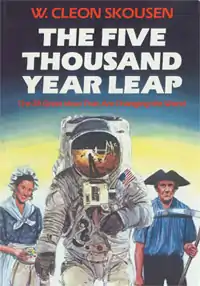The Five Thousand Year Leap
The Five Thousand Year Leap: Twenty-Eight Great Ideas That Are Changing the World is a book that was published in 1981 by US author W. Cleon Skousen. The book asserts that the United States prospered because it was established upon universal natural law principles that had been passed down from common law and traditional Judeo-Christian morality, as many of the Founding Fathers had been guided by the Bible, among others. Thus, the U.S. Constitution incorporates enlightened ideas.[1][2]
 | |
| Author | W. Cleon Skousen |
|---|---|
| Country | United States |
| Language | English |
| Genre | Christianity Mormonism Political Science American history |
| Publisher | National Center for Constitutional Studies |
Publication date | June 1981 |
| ISBN | 978-0-88080-004-4 |
Ronald Mann's introduction to the 10th-anniversary edition praises Skousen for grasping the country for choosing "Christ or Chaos" and for acknowledging that its future depends on "accepting and demonstrating God's government."
Criticism
Princeton University historian Sean Wilentz, a self-described humanist, disputes the book's claims on taxes, the redistribution of wealth, the separation of church and state, and the "In God We Trust" motto.[3] Wilentz describes The 5,000 Year Leap as "a treatise that assembles selective quotations and groundless assertions to claim that the US Constitution is rooted not in the Enlightenment but in the Bible and that the framers believed in minimal central government."[3] Wilentz claims that those assertions are not true:
Either proposition would have astounded James Madison, often described as the guiding spirit behind the Constitution, who rejected state-established religions and, like Alexander Hamilton, proposed a central government so strong that it could veto state laws.[3]
Wilentz acknowledges that the Founding Fathers rejected what Samuel Adams denounced as "utopian schemes of leveling," but he notes that some of the Founding Fathers were quite pragmatic when it came to policy specifics.
See also
References
- W. Cleon Skousen - The Man Behind Glenn Beck By Bill McKeever. Mormonism Research Ministry
- Meet the Man who Changed Glenn Beck's Life. Zaitchik, Alexander (2009-09-16). Salon Magazine, September 16, 2009.
- Confounding Fathers: The Tea Party’s Cold War Roots by historian Sean Wilentz, The New Yorker, October 18, 2010